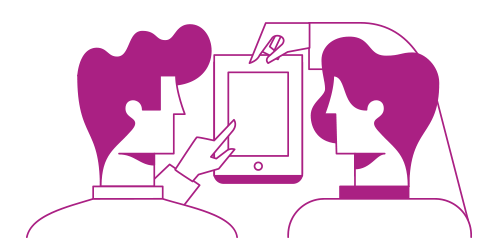At mental healthcare institution Mindfit, the customer is being given more and more control. But it took time and energy for strategic policy adviser Sabine Jansen to get healthcare providers interested in ‘ehealth’. ‘In the beginning, I would print out the modules as if they were forms so that the practitioners could fill them in with a pen.’
 Sabine Jansen, strategic policy advisor at Mindfit
Sabine Jansen, strategic policy advisor at Mindfit
What could be done digitally, should be done digitally. This became Mindfit’s working method from 2014, after the change to the system that resulted in the introduction of the so-called ‘General Basic Mental Health Care’ category. ‘When recruiting personnel, we always explain that we strive to make all our processes as digital as possible. If this doesn’t suit you, then you should think carefully about working for us,’ says Jansen. She says working online, including providing online support, is not something that should just be viewed as an optional extra. ‘On the contrary, it is an essential part of the work. The focus is on ensuring that the service user remains in control at all times, regardless of the nature of the problem.’ According to Jansen, you should always be able to take action yourself. ‘Everyone is online. Since it’s already so common, why shouldn't the same apply in care?’
Nevertheless, working online remains a challenge. ‘Especially in the area of psychological care,’ as Jansen explains. ‘Care workers are not trained in it, and many are still working with old methods based on seeing, speaking with and ‘feeling’ the patient. We wanted to change all this.’ When asked how they managed, as they often are, Jansen explains that they did it in small steps. ‘When Mindfit started in 2014, I made short summaries of the modules we had, and then indicated to healthcare providers when they could use something. This would typically involve answering questions like: “What is the core of the module?” or “How many sessions are needed?” At that time, it wasn’t digital at all. I’d even print out the forms from the modules, so people could complete them on paper! It was at times like that that that I really started to wonder what I was doing.’ But she is also able to laugh about it. ‘As long as it helped I was happy to do it. But once they discovered all the advantages of online care it started to take off. Although the first steps were difficult, change happened quickly.’
To work
‘At Mindfit, we focus on the service user, and it turns out that our users do want to do things online,’ says Jansen. ‘When you go to the hospital, you have to do all kinds of preliminary examinations before you make it to the specialist. Why isn’t this the case in the mental health care system?’ Mindfit saw possibilities here, asking why service users were not able to prepare themselves before meeting their practitioner. ‘After all, you know where your problems originate. We think people can make a start on their problems themselves.’ In this way the care worker also has access to much more information in advance, even before the first meeting with the client.
The registration process is fully digital, and more than half our customers complete the welcome module.
Each customer is offered an online welcome module, which more than half of Mindfit’s customers go on to complete. Of course, there will always be customers who don’t want to complete the welcome module, but Jansen doesn’t mind. ‘In these cases, we simply identify the problems during the first interview using the methodology and the module, together with the healthcare provider. In this respect it has been a win-win situation, because if customers had already filled in something, care workers would be forced to work online, and thus familiarise themselves with Minddistrict.’ This means working with ehealth isn’t the exception, but rather ‘business as usual’, Jansen emphasises.
The modules were first used sparingly, but the busier the practitioners were, the more they realised that the other modules could also be used as homework. They also soon realised that another advantage of the modules was that they offered an important bit of extra support in addition to the therapy people receive in General Basic Mental Health Care. ‘I think this is extremely valuable. General Basic Mental Health Care treatment processes are fairly short, but problems are becoming more and more acute and complex. If you want to be effective, you have to be creative and see what the person can already start working on at home.’
'Working with Minddistrict is not an exception, but rather ‘business as usual’'
A large part of helping someone is explaining how things work, even on such a basic level as explaining what a diagnosis actually means. ‘Minddistrict has great modules for this. Care providers can have people read them online and then ask them how it went. They can look at the assignments someone has done and discuss them. You don’t have to spend a whole session on this.
Not only does this allow you to use your customer’s time much more efficiently, but it also results in greater time efficiency for the care provider,’ says Jansen. ‘You can immediately start talking about any problems you had while doing the assignments, or about what you found helpful, allowing you to get straight to the point. For a long time, the general idea of people entering our service was: ‘the specialist will ‘fix me’’, but this understanding has changed. If you ask me, it’s great to see that people can work on their problems themselves, at their own pace, when it suits them, and supported by high-quality, easy-to-use modules.’
Encouraging people to work online
Service users need to be on board for ehealth interventions to work. Is this also the case with Mindfit? ‘People often mention the so-called “80-20 rule”. This rule is usually applied to billable time, but for me it translates as follows: 80% of customers want it, 20% don’t. Our motto is: it’s not mandatory, but we very much recommend it. In Mindfit’s introductory letter, the customer is encouraged to start with the module. Just try to complete as many questions as possible. If you don’t manage, no problem. Just see how far you get, that’s our message.’
'Filling out the welcome module provides people insight'
This type of care is more about putting the service user in control. Jansen sees a turnaround in healthcare: ‘These days, care providers are taking on more of an expert advisory role. Instead of simply ‘caring for you’, they now give you advice, guide you in taking the right steps, and identify tools you may have in your toolbox that you can use to move forward.’ Mindfit says people’s responses have been positive. ‘Merely filling out the welcome module can already provide people with a great deal of insight. By doing this, people can discover where their problems lie, or they might discover what their goals are.’ Jansen also believes that it’s better to discover all this for yourself. ‘It is then a good idea to involve experts in order to strengthen your mental well-being. It’s the same as with physical exercise: you have to work at it. Society is rapidly changing, and a lot is being asked of and expected of people. Being mentally fit is therefore indispensable.’

Solution oriented
Mindfit’s customers have access to 164 modules, but not all of them are suitable for the organisation’s basic remit, according to Jansen. ‘We work in a solution-oriented manner and from the perspective of positive psychology. Many of the modules are still focused on complaints. We make extensive use of generic modules, basic care modules, modules on self-image and a number of psycho-educational modules. This allows us to offer just that little bit extra.’
The organisation is investigating the influence of this method – working digitally and making your own choices – on the sustainability of the treatment. ‘Do people actually come back less often if they have more control? Are they experiencing fewer problems in the longer term? We are now investigating this together with the University of Twente. It is part of a doctoral research project, so it may take some time before the results are available. At the moment, we can see the percentage of customers who start working with ehealth from the very beginning, compared to when we started.’ Whereas in 2014 this was still about 25 per cent of Mindfit’s customers, this grew to 50 per cent in 2017.
2014: 25% get started with ehealth 2017: 50% get started with ehealth
This may come as a surprise, but in essence, Mindfit is not about efficiency, stresses Jansen. ‘The aim is to facilitate customers as much as possible and to put them in charge of their own life again. The dominant focus on efficiency is precisely the reason, in my opinion, that ehealth was so misinterpreted in the early years. The perception was it was about making a profit; speaking to as many as three or four customers in one session. But that’s not the right way to go about things, if you ask me.’ Previous research within the Dimence Group, of which Mindfit is a member, showed that someone who is treated online will be more likely to attend face-to-face appointments. ‘In addition, there is increased customer satisfaction,’ says Jansen. ‘We refer to this as “compliance”, which I think is high.’
Further digitalisation
In the future, Mindfit wants to emphasise the online working method even more. That is, they want to point out to people from the very beginning that it plays a major role in providing assistance. Meanwhile, the registration process is already fully digital. ‘For example, we’re also considering a questionnaire to ascertain whether people are suitable for Mindfit and our working method. This would allow us to better rule out surprises or disappointments.’
’How do we continue to provide good care and help our customers as best we can?’
Treatment model 2.0 has six steps, Jansen explains. All of them need to be provided with a supporting digital tool. ‘We have now digitised four steps. In addition, we will be focusing more on a customer portal in which all care components will be made available to the customer. The Dimence Group has developed a customer portal in which the file and processing results can be viewed, and which offers direct access to various modules. This can be further expanded.’
In the end, the whole process should require fewer people. ‘We are always expecting to face staff shortages, so the question is: how do we continue to provide good care and help our customers as best we can? We will need to look at how much the customer can do themselves and how technology can offer them a helping hand.’ The pressure on moments of personal contact with the care provider will thus be reduced, according to Jansen. ‘The ‘Living life to the fullest’ module is a good example of this. It consists of nineteen sessions during which you see a healthcare provider three or four times. These modules take a critical look at how things are going in your life, if you are managing, and whether the changes you are making are having an effect. This is the direction we are going in.’
Enjoyed the read?
You might be interested in the other anniversary interviews too:
- 'If you want to change something in your life, you have to practise.'
- ‘Thanks to ehealth, clients are able to help themselves.’
- 'About 50% of all patients receive online therapy, which includes virtually every young person.'
Can we help?
Do you have questions about the Minddistrict platform?
